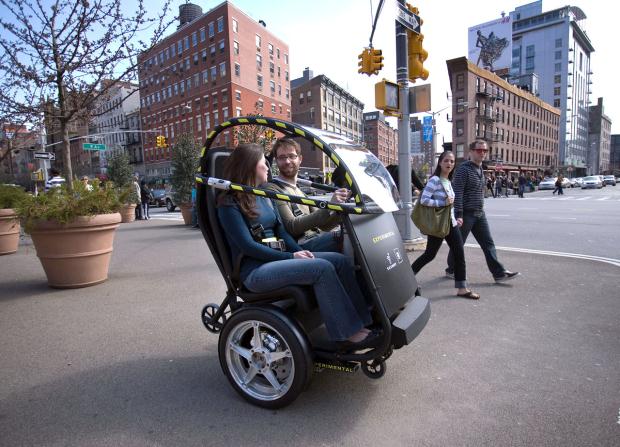Will the P.U.M.A. change transportation?
 A number of media outlets today noted the unveiling of the P.U.M.A., short for Personal Urban Mobility and Accessibility, from GM and Segway.
A number of media outlets today noted the unveiling of the P.U.M.A., short for Personal Urban Mobility and Accessibility, from GM and Segway.
"Think of a larger, two-passenger, sit-down version of the Segway PT, with two gyroscopically balanced wheels. The prototype has minimal bodywork, but podlike enclosures (which look like computer mice on wheels) are imagined for production," writes Jim Motavalli in The New York Times' Wheels blog.
The electric vehicle is powered by lithium-ion batteries and can reach a top speed of 35 m.p.h., and it is so small that six P.U.M.A.s could fit within a standard parking space.
The companies don't plan to sell the vehicle at this time, but are showing it off as "a bit of blue-sky thinking about better ways to move around crowded urban areas." Indeed, with a presumed cost higher than $5K (Gothamist notes that a standard Segway PT costs bout $5K), it's price point may be too close to value automobiles that offer more space, cargo, and horsepower.
Perhaps PSFK's Dan Gould offers the best commentary on this new vehicle, noting that while this thing is "kind of cool, no [doubt,] wouldn’t a bike be a better, less complicated solution for urban transport?" Not to mention cheaper, smaller, and completely energy-neutral.
What's really exciting about planned future innovation for these vehicles, however, is in their communicative abilities, both with each other, and with a central power grid. Larry Burns, G.M.’s vice president for research and development and strategic planning, told the Times that
Project P.U.M.A. vehicles would be designed to tap into the two-way communications made possible by G.M.’s OnStar technology, which has six million North American subscribers. The vision is expansive: using 'vehicle to vehicle,' or V2V, communications, these '100 percent digital' devices would communicate with one another over a quarter-mile range to prevent collisions, eventually allowing what G.M. calls 'autonomous driving and parking.' . . .
There’s more: the pods would also be equipped to communicate with the smart grid of the future (as is the Aptera EV, another podlike electric vehicle that is due to be introduced in the fall), returning electricity to utilities during times of peak demand. That’s not V2V, it’s V2G — vehicle to grid.That is an innovation that would change transportation.
"The Project P.U.M.A." image by yufujamar.





0 comments:
Post a Comment